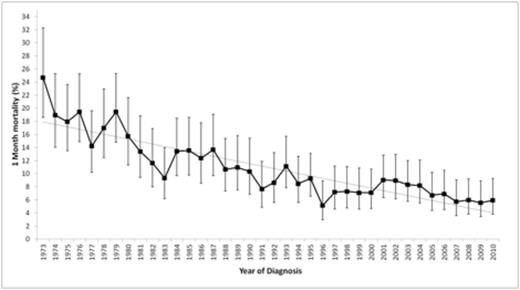Abstract
Purpose: Acute myeloid leukemia (AML) is treated with conventional induction chemotherapy shortly after diagnosis in most patients less than or equal to 65 years old, most commonly combining infusional cytarabine with an anthracycline. Fatalities from infectious or bleeding complications related to cytopenias within 30 days of diagnosis (known as early death or treatment-related mortality) are routinely reported in these patients. Recent data from patients treated on clinical trials suggested a decline in the early death rate over the past two decades. It is unknown if a similar improvement has been observed in the general population.
Methods: We examined the 30-day mortality and overall survival (OS) in a large population-based series of 9,380 AML patients reported to the National Cancer Institute's Surveillance, Epidemiology, and End Results (SEER) program. Included patients were diagnosed with AML between 1973 and 2010, were between the ages of 18 and 65 at diagnosis, and were treated with chemotherapy. We stratified patients by age and geographic location at diagnosis.
Results: We observed a significant improvement in median OS from 6 months (95% CI 5-7) in 1973-1977 to 23 months (95% CI 16-20) in 2008-2010 (p < 0.001). During the same study period, the 30-day mortality rate declined from 18.7% among patients diagnosed in 1973-1977 (95% CI 16.4-21.2%) to 5.8% for those diagnosed in 2008-2010 (95% CI 4.5-7.6%) (p < 0.001). Weighted linear regression analysis revealed a strong linear trend in the 30-day mortality rate (R2 = 0.78), with an average annual decrease in the early death rate of 0.4% per year throughout the study period (β = 0.3755; Figure 1). When analyzed by age, the largest absolute improvements were noted in older patients (approximately 15% absolute decrease in 30-day mortality for patients aged 51-65 over study period). Though location at diagnosis significantly influenced 30-day mortality in 1973-1977, these differences in early death rate were no longer evident in the most recent time period (2008-2010). The patient characteristics remained stable over time with a median age at AML diagnosis of 50.
Conclusion: Over the past four decades, significant improvements in median OS and 30-day mortality have occurred in our large cohort of younger patients (less than or equal to 65 years) with newly diagnosed AML undergoing chemotherapy. The largest improvements over time were noted in the oldest age group and in regions with intermediate to high early mortality in the earliest time period (1973-1977). The decrease in 30-day mortality appears to partially account for the increase in median OS observed over the past 4 decades. These data suggest that risk of early mortality has decreased and should not prevent younger patients with AML from receiving aggressive initial treatment modalities.
30-day mortality (%, 95% CI) for AML patients, by year of diagnosis, SEER 9 Registries, 1973-2010.
30-day mortality (%, 95% CI) for AML patients, by year of diagnosis, SEER 9 Registries, 1973-2010.
No relevant conflicts of interest to declare.
Author notes
Asterisk with author names denotes non-ASH members.


This feature is available to Subscribers Only
Sign In or Create an Account Close Modal